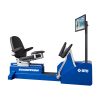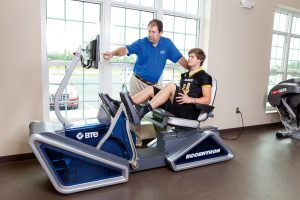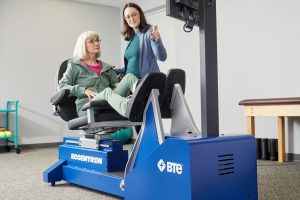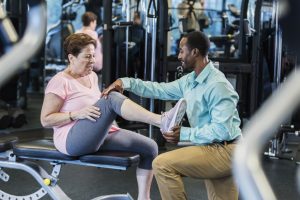
Hip Fracture Recovery: Boost Muscle Mass, Force Production, and Functional Abilities
Treatment GuidelinesA recent study examined the outcomes of an eccentric-focused physical therapy program for post-hip fracture recovery. Participants using BTE's Eccentron showed positive improvements in lean muscle mass, force production, and functional abilities.
As physical therapists and occupational therapists, we know that our patients often face significant challenges following a hip fracture. The road to recovery can be long and arduous, with muscle mass loss and impaired function taking a toll on their independence and quality of life. Experience has taught us how important lower extremity strength and function are for older adults. They play a key role in preventing falls, maintaining independence, improving mobility, and boosting overall quality of life.
A recent study measured lower extremity muscle mass, force production and functional abilities in post-hip fracture adults. Study participants completed a specialized physical therapy treatment program. The results after the intervention revealed major improvements in all three areas, crucial for falls prevention and overall mobility.1 Keep reading for a summary of this clinical study, its results, and how you can boost your patients’ muscle mass, force production, and functional abilities.
Hip Fracture Recovery: An Overview
As we’ve all experienced, hip fractures are unfortunately common, especially among older adults. Each year, about 300,000 hip fracture-related hospitalizations occur due to falls among older adults.2 In particular, women experience about 70% of hip fractures treated in emergency departments or hospitals.2 As we know, these injuries profoundly impact our patients’ lives, often leading to extended hospital stays, prolonged recovery periods, and a decrease in functional abilities.
Despite improvements in surgical techniques and rehabilitation protocols, hip fractures continue to pose a significant public health challenge, with trends showing variations in incidence rates across different demographic groups. 3 Muscle mass deficits may persist long after the initial injury, contributing to a reduced quality of life and increased dependency. 2 While our traditional rehabilitation approaches aim to restore strength and function, the lasting effects of muscle loss necessitate more effective interventions.
Typical Physical Therapy Approach to Hip Fracture Recovery
Our conventional physical therapy approach for hip fracture rehabilitation typically involves a combination of exercises to improve strength, flexibility, and functional mobility. This often includes progressive resistance training, balance exercises, and gait training. The timing of these interventions is crucial for addressing deficits and achieving desired outcomes4. While these interventions have shown efficacy, there is growing interest in more targeted approaches that can potentially yield better outcomes, especially in addressing persistent muscle mass deficits5.
New Research: Improving Muscle, Force, and Function Post-Hip Fracture
A recent study evaluated the efficacy of eccentric muscle training in improving muscle quality among older adults recovering from hip fractures. The research focused on participants who were approximately three months post-hip-fracture and had recently completed standard physical therapy5.
The exercise protocol consisted of 12 weeks of eccentric-focused resistance training using the Eccentron device. The researchers measured several key aspects of muscle quality and function:
- Muscle tissue quality: This was assessed using a 3.0 Tesla whole-body MR imager to measure lean muscle mass and intramuscular adipose tissue (IMAT) of the quadriceps and calculated by dividing peak isometric knee extension force by quadriceps lean muscle mass. This measure provides insight into the force-producing capability of the muscle relative to its size, offering a more comprehensive view of muscle function than size or strength alone2.
- Peak isometric knee extension force: Measured using an isokinetic dynamometer.
- Functional abilities: These were assessed using common physical function variables.
Baseline measurements were taken before training, with follow-up assessments conducted after the intervention period. This comprehensive approach allowed the researchers to evaluate not just changes in muscle size, but also improvements in muscle quality and functional performance, providing a more holistic view of the intervention’s effects5.
Why Eccentrics for Older Adults?
To fully appreciate the benefits of eccentric exercise, it’s crucial to understand the distinction between concentric and eccentric muscle contractions. Concentric contractions occur when a muscle shortens as it generates force, such as when climbing stairs or standing up from a chair. In contrast, eccentric contractions involve muscle lengthening under tension, as seen when descending stairs or lowering oneself into a chair. For example, in the lower extremity, the quadriceps muscle undergoes an eccentric contraction as you descend stairs, controlling the knee’s flexion against gravity.
Eccentric exercise offers several unique benefits that make it particularly suitable for rehabilitation, especially in older adults recovering from hip fractures:
- Lower energy requirements: Eccentric contractions are inherently more energy-efficient than concentric contractions. This efficiency stems from the ability of muscles to store and utilize elastic energy during lengthening, significantly reducing the overall metabolic cost. As a result, eccentric exercises demand less cellular energy (ATP) 6,7.
- Lower oxygen consumption: Eccentric exercise requires less oxygen than concentric exercise for the same amount of mechanical work6,7.
- Lower perceived exertion: This makes eccentric exercise more tolerable for elderly, injured, or atrophied limbs7.
- A safer option for those with cardiac limitations: The lower oxygen requirement makes eccentric exercise safer for those with cardiac limitations or who are unable to tolerate intense cardio exercise7.
- Efficient muscle building: Researchers have long regarded eccentric exercise as the most efficient way to build muscle in the lower extremities
The Eccentron is the only device that maximizes these benefits by isolating eccentric contractions of the lower extremities. In addition, it provides detailed objective data on several aspects of the users’ performance. The automated progress reports include data on maximum and average force production, accuracy in hitting the target force, bilateral comparisons, and changes between sessions. For these reasons, researchers have long used the Eccentron to study lower extremity exercise.
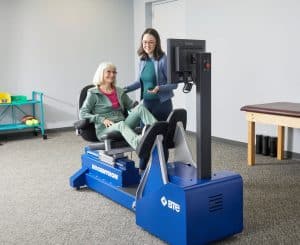
New Research Results: Eccentrics Effectively Increase Muscle Mass, Force Production, and Functional Abilities
The results of the 12-week Eccentron training showed encouraging benefits for hip fracture recovery:
- Lean quadriceps muscle mass: Notable improvements in lean quadriceps muscle mass on both the surgical and non-surgical sides, indicating a balanced increase in muscle mass.
- Force production: Enhanced force production in the surgical limb, indicating the effectiveness of eccentric training in restoring strength.
- Functional abilities: Significant improvement in functional abilities, such as walking speed and balance, which are crucial for reducing fall risk and enhancing overall mobility.
Specifically, the study found that surgical and nonsurgical lean quadriceps muscle mass improved among participants (mean change: 2.9 cm2 ± 1.4 cm2, and 2.7 cm2 ± 1.3 cm2, respectively). Peak force improved in the surgical limb by 43.1 ± 23N.
These findings underscore the effectiveness of eccentric training for hip fracture recovery. The increase in muscle mass and function not only aids in immediate recovery, but also provides long-term benefits in maintaining in dependence and quality of life for adults recovering from hip fractures.
Conclusion
The results of this study provide compelling evidence for the effectiveness of eccentric resistance training in hip fracture rehabilitation. The improvements in muscle mass, strength, and functional abilities suggest that physical therapy treatment with Eccentron significantly enhances recovery outcomes for patients post-hip fracture.
As physical therapists, we should consider incorporating eccentric training, particularly using devices like the Eccentron, into our treatment protocols for hip fracture patients. The lower energy requirements and perceived exertion make this approach particularly suitable for older adults who may have limited exercise tolerance.
At BTE, we promote evidence-based treatment with our physical therapy equipment like the Eccentron. With the Eccentron, you tap into all the musculoskeletal and neurological benefits of eccentric training. Appropriate for geriatrics to athletics, it’s one device that delivers engaging, research-proven treatment for your whole practice. Plus, the automated objective progress reports make it easy to track and share progress with patients and referrers. Interested in the Eccentron for your practice? Get a quote today.
Get a Quote
Hannah le Roux, OTR/L, CHT, is an experienced Occupational Therapist and Certified Hand Therapist with over two decades of international practice across South Africa, the United Kingdom, and the United States. Now, Hannah leverages her extensive expertise as a consultant, guiding fellow therapists in clinical patient care strategies and authoring insightful articles.


